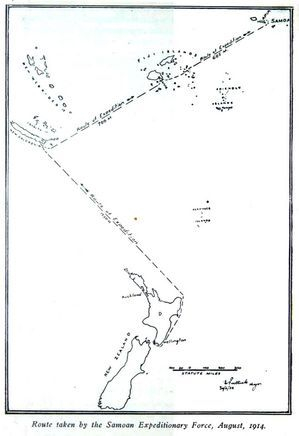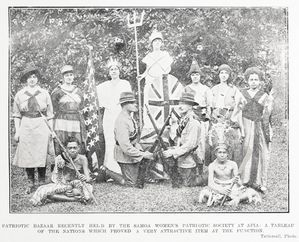During the build up to the
outbreak of war, the British Government
decided to invade the German possessions
of New Guinea and Samoa to prevent
attack on the British colonies of the
Pacific, and arranged with the French,
Australian and New Zealand Governments
to send a fleet of allied ships to
Samoa, carrying New Zealand troops, and
another fleet of Australian ships and
troops to New Guinea. On 6 August 1914
Britain???s Secretary of State, Sir
Lewis Harcourt, sent a telegram urging
New Zealand???s Governor General to send
a force to seize control of German
occupied Samoa.
The New Zealand Samoa Advance
Force left Wellington on 14 August 1914
on board the transport ships Moeraki and Monowai,
converted merchant steamers. They were
escorted to Noumea, New Caledonia by
three Royal Naval ships of the New
Zealand Division - HMS Psyche, Philomel and
Pyramus,
and two colliers NZ Colliers Katoa and Koromiko. In
Noumea these ships were joined by the
French warship Mont
calm, and the Australian
cruisers Australia
and Melbourne.
The fleet then proceeded to Suva, Fiji,
where ten Legion of Frontiersmen and
thirteen Samoan guides joined them. They
sailed for Apia, arriving there on 29
August 1914, landed the New Zealand
troops, captured the German flags and
raised the British flag on the Apia
Courthouse.
During 1914,
several Samoa-born men living in Australia
and New Zealand
enlisted in the Australian
Imperial Force and the New Zealand
expeditionary
Force and were sent overseas
to fight at Gallipoli. This campaign
lasted 240
days and by 20 December 1915
all the ANZAC troops had been withdrawn.
Recruits from Samoa during
1915 were sent to fight in France and
Belgium,
the Western Front, in various
New Zealand regiments. A recruiting party
from the New Zealand Samoan
Force left Apia for Tonga in January 1916,
with some recruits from
Western Samoa. They and the Tongan
recruits
arrived in New Zealand later
in 1916 and enlisted in the Maori
Reinforcements. They served
firstly on the Western Front and
later in
Palestine. Individuals,
usually Englishmen living in Samoa,
enlisted in the
British Forces.
Various organizations were
set up to raise money for the welfare of
the
troops, by holding bazaars
and other entertainments. Money was
raised for
the Belgian Relief Fund, the
Hospital Ship Fund, the Wounded
Soldier's
Fund, the Samoa Soldier's
Benefit Fund, the Wounded Aviator's
Fund,
the Apia Women's Patriotic
Fund and the Red Cross by various
fund-raising
efforts. Two beds at Netley
Hospital were financed by the Apia Women's
Patriotic Fund. .
|


|